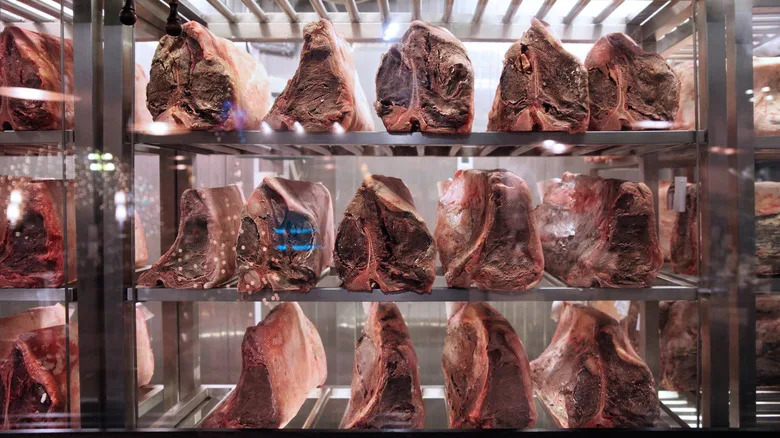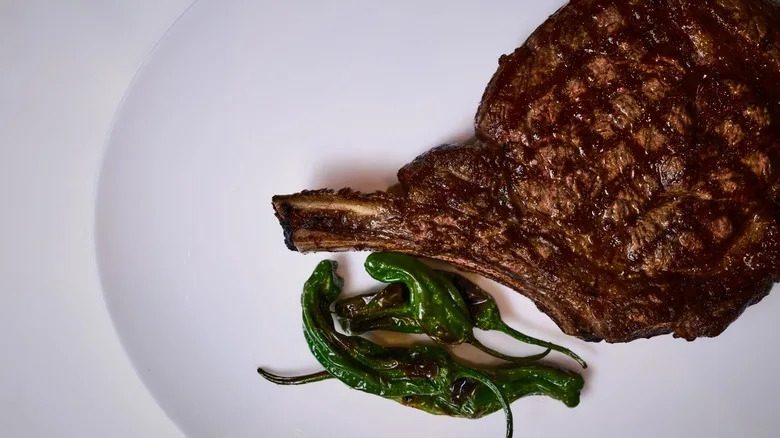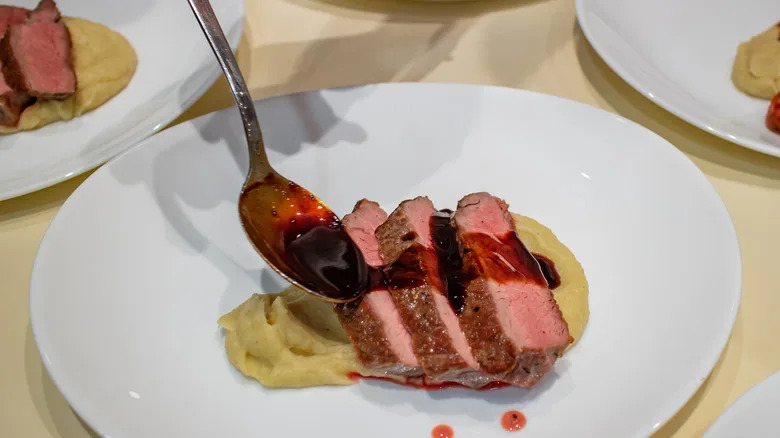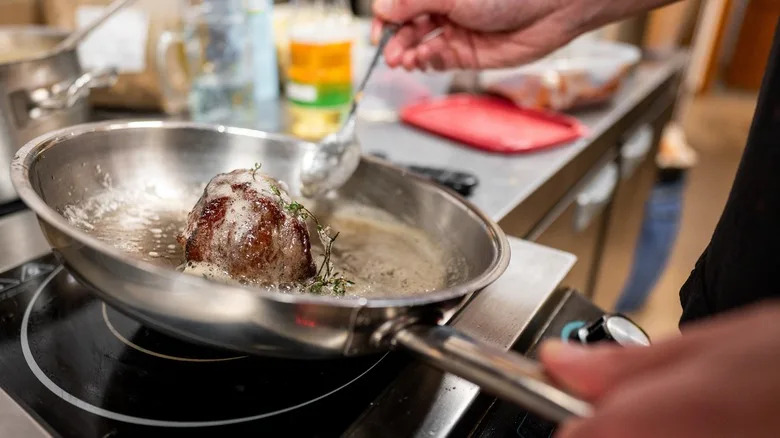If there is a chef on this planet who understands the complexities of cooking the perfect steak every time, it is Jean-Georges Vongerichten. The celebrity chef, cookbook author, and restaurateur has been honing his craft for several decades. He is the mastermind behind 60 restaurants globally, including at the popular Jean Georges Steakhouse in New York City and Bellagio Fountain Club in Las Vegas.
His unique culinary style fuses his French heritage with his extensive training and experience traveling and working across Asia. Many of the techniques he applies to elevate a steak are a product of this marriage of traditional French cuisine with exotic and aromatic Asian flavors.
Chef Vongerichten has been gearing up for the upcoming Formula 1 Heineken Las Vegas Grand Prix, which is slated to be held at the Bellagio Fountain Club this coming November, where he will be joining other well-known Michelin Star chefs to create an unforgettable gourmet dining experience. Tasting Table had the chance to catch up with the chef ahead of the event to ask him about his top tips and techniques for transforming an ordinary steak into something worthy of a Las Vegas high-roller.
Read more: The Most Popular Cuts Of Steak Ranked Worst To Best
Consider dry-aging beef for maximum flavor
Portions of beef dry-aging in controlled environment – Ozina/Getty Images
While Jean-Georges Vongerichten didn’t invent the technique of dry-aging beef, he regularly employs the method at his steakhouses. The process of dry-aging beef is relatively simple. It involves placing large portions of raw, unwrapped beef into temperature- and humidity-controlled environments for a period of anywhere from seven to 120 days. What dry-aging does to beef and steak during this time is effectively allow for controlled decomposition to occur.
As the natural enzymes and lactic acid within the meat begin to break it down, not only does the beef begin to lose excess moisture, but Vongerichten explains that it develops a more intense umami-rich flavor. “It just gives … umami flavor, [and] the marbling becomes a little more [pronounced],” Vongerichten told Tasting Table.
As for the ideal length of time to dry-age beef? Vongerichten points out that about 28 days is the sweet spot. “Sometimes people age it to 100 days,” he told Tasting Table exclusively. “I don’t like it when it’s too dry-aged, that’s when you lose a lot of the moisture of the beef. So I think that’s a perfect amount of days to age it. It just makes it special, you know? The flavor of the beef, the softness, tenderized.”
Use koji to give steaks a melt-in-your-mouth texture
Raw koji in decorative wooden box – KOHUKU/Shutterstock
Another unique technique that Jean-Georges Vongerichten has been experimenting with to give steaks a melt-in-your-mouth texture is marinating the meat in koji. Koji is a Japanese mold that has been a mainstay of the culinary traditions of this country for centuries. It is used as a seasoning and curing agent for a wide variety of ingredients, including the production of miso paste and sake.
Koji is typically used in conjunction with cooked grains — in this case, rice. The chef told Tasting Table, “We rub the beef with it. … We let it marinate for a couple hours, and it really penetrates and makes the meat so sweet.” Once prepared, the meat not only is tenderized, but it smells like sake and develops a distinctive taste that amplifies the savoriness of the beef. It is unlike anything the chef is currently serving at his empire of restaurants, which is why he is eager to introduce it to diners this fall.
Vongerichten remarks that koji isn’t just for beef. There are a number of ways to use koji, from soups to baking bread. “It transforms everything,” he told us. “You can put it on a piece of chicken, a piece of fish, or even on a vegetable. We tested the other day on a slice of tomato. It’s like a new tomato.”
Japanese flavors are the key to restaurant-quality steak
Grilled bone-in ribeye steak on white plate garnished with shishito peppers – PRIME Steakhouse at Bellagio in Las Vegas
When it comes to infusing steaks with flavor, Jean-Georges Vongerichten leans heavily on the use of Japanese flavors and condiments. Though classic condiments like mustard and mayonnaise will change the way you cook meat forever, he takes things a step further. The chef told Tasting Table exclusively that many of the sauces and marinades he uses at his restaurants are blends of classic Japanese and French flavors.
“I love steak with just a little sea salt and wasabi,” Vongerichten said. “I ate that in Japan, so I brought it to the steakhouse as well.” He also said he uses miso mixed with butter and mustard and a black pepper condiment that is made with fermented black beans. He also enjoys a green chili sauce on steak. “We take jalapeño, we blend it in a blender, and take the seed out. Just blend the jalapeño, add a little salt, add a little bit of grapefruit peel. I’ll let it marinate aside for 24 hours. … It’s just delicious on a steak. It’s that magic.”
As far as seasonings and spices go, though the chef tends to keep things relatively simple, he will occasionally use some unique ingredients to amplify the flavor of the beef. One such ingredient is porcini mushroom powder, which gives steak an earthy, umami-rich flavor. Another is a citrus-based dust made from ground orange peels, which can add flavor to all kinds of meat, from beef to shrimp.
Use a red wine reduction to transform a steak
Steak served with red wine reduction over mashed potatoes on white plate – Andrej Filipovic/Getty Images
Though Jean-Georges Vongerichten is a fan of many classic French sauces for steak, especially a perfectly velvety and slightly tangy béarnaise, he does occasionally opt for simplicity. A recipe he was taught as an apprentice was for a basic red wine pan sauce. “Sear the steak, take it out of the pan, smash some garlic in the pan — the same pan — [and] a little bit [of water],” he told Tasting Table. “Put some red wine, reduce it until it’s a syrup. Add a little butter in it. It’s like a red wine syrup on the beef. Delicious. Amazing. So I do that sometimes at home. … It’s just garlic and red wine reduced to a syrup, and then a little butter on it. It’s magic.”
If you’re preparing a red wine pan sauce at home, an underrated wine that makes the best pan sauce is marsala. This fortified Italian wine is distilled with a grape spirit, such as brandy, which increases its alcohol content and adds a layer of complexity to its flavor. If you are searching for ways to level up a red wine sauce, there are a number of ingredients you can add to bolster flavor and texture. Among the more interesting ones are fresh herbs, bonito flakes, or tamari, which fit in well with the Japanese and French fusion that chef Vongerichten loves so much.
Cook steak in butter for the beefiest taste
Chef butter-basting steak in hot pan – siamionau pavel/Shutterstock
According to Jean-Georges Vongerichten, perhaps the best way to obtain that steakhouse flavor from beef is to butter baste it. Basting steak with butter allows for it to obtain that perfect sear on the outside, while giving it a delicious flavor and a moist texture. That said, the chef also enjoys using a wood burning grill, though he cautions, “You don’t want too dark of grill marks, otherwise [the taste] gets really metallic.”
Another alternative Vongerichten likes when preparing steak in a cast-iron pan. “What I like at home is a cast iron for cooking my beef,” he told us in an exclusive interview. “The heat is distributed really all the way the same. You use a regular pan, sometimes it gets hot on one side, the other side. Cast iron is hot all the way, so it sears it perfectly. Love it.” The key to cooking steak in a cast-iron pan to use a cast iron pan that is perfectly seasoned, which is as simple as using it regularly.
Lastly, the chef swears by an ultra bougie technique for cooking steak that he employs at his restaurant in New York. This method requires an immersion circulator that can cook the steak using the sous vide cooking method. “We actually warm it up in beef tallow with a temperature articulator,” he told Tasting Table. “We bring it up to 100 degrees, so [while] people read the testing menus … your beef is warming up on that beef tallow, absorbing a little bit of the tallow, beef flavor. But then we just sear it and serve it. It’s like magic.”
For the ultimate luxury, Kobe is king
Block of Kobe beef on table – Jean Georges Steakhouse at ARIA Resort & Casino in Las Vegas
Jean-Georges Vongerichten’s steakhouses in both Las Vegas and New York serve a variety of different types and cuts of beef. Though there are plenty of USDA Prime cuts to select from, the chef appreciates the luxury of Wagyu and Kobe beef, both of which are available for purchase in a number of cuts, including the coveted ribeye cap.
Though American Wagyu can be a good option because it is less fatty, Vongerichten prefers Japanese Wagyu and Kobe for his restaurants. “A piece of the Japanese Wagyu is so rich, and it’s almost half and half meat and fat, sometimes even more,” the chef told Tasting Table. “I can only eat a couple bites. But with wasabi, a little sea salt — magic, again.”
When cooking Wagyu or Kobe steaks, the chef cautions, it can be a challenge to prepare correctly. “If you put it in the pan or on the grill, it will be too much flame flaring up the fat,” he told us in an exclusive interview. “I like to use … the plancha, the flat top, and just sear it like that.” The plancha or flat top allows for the fat to be seared without flaring up, and it imparts a smoky flavor to the meat.
Never pre-slice a steak before serving it
Grilled Wagyu ribeye on plate with shishito peppers – Jean Georges Steakhouse at ARIA Resort & Casino in Las Vegas
When asked about his preferred methods for slicing and serving a steak, Jean-Georges Vongerichten told Tasting Table, “Unless you come to the table and we slice table side, then you really get the aroma and the juices are there in front of you. But slicing in the kitchen, serving in the restaurant, no.” The biggest issue with pre-slicing a steak in the kitchen is that it will lose all of its juices and dry out before it ever makes its way to the table. The chef said it is best to allow the steak to rest and then plate it whole, allowing for guests to cut each piece as they are eating it.
That said, the chef does offer tableside carving for a couple of the restaurant’s specialty cuts, including a 36-ounce porterhouse steak that can easily serve two to three people. Since the porterhouse comprises two different cuts, the filet mignon and a New York strip, it is crucial to treat each as a separate unit when carving this steak. Each portion should be removed from the bone and then cut against the grain to the desired thickness.
Read the original article on Tasting Table.


Dining and Cooking